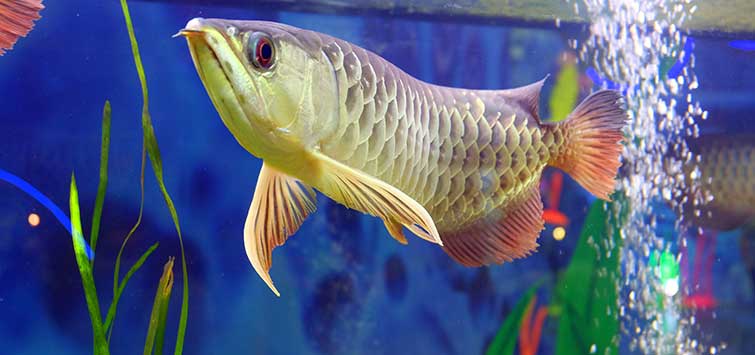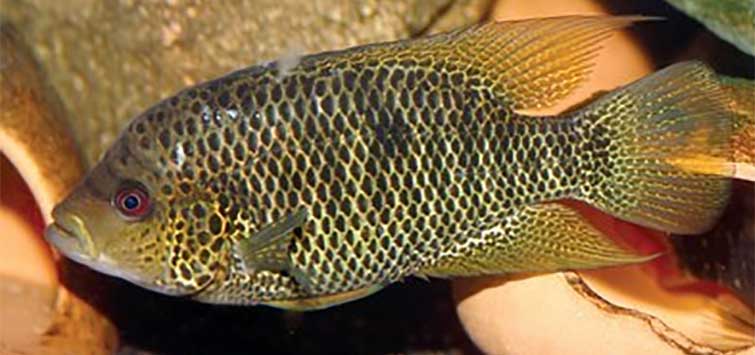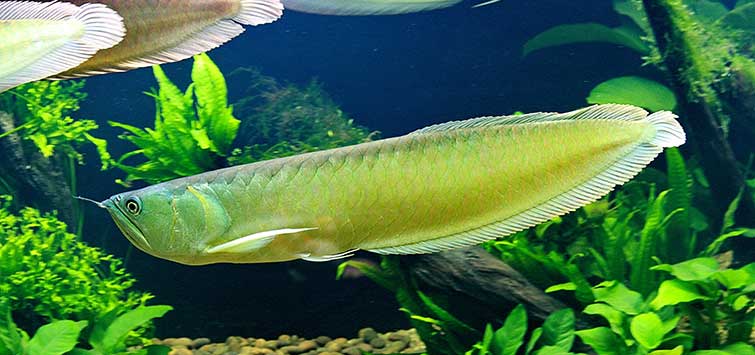A Rare Experience With an Endangered Species
Author: Al & Olympia DiSpigna
Assisting the U.S. Fish and Wildlife Service, longtime fishkeepers Al and Olympia DiSpigna had the rare opportunity to keep eight Asian arowanas, federally protected fish illegal to possess in the United States.
A Unique Opportunity Presents Itself
In early February 2004 we received a call from Inspector Kathy Nucci of the U.S. Fish and Wildlife Service (FWS). They had recently confiscated eight Asian arowanas illegally entering the country. It seems in the past that the institutions (aquariums, universities, etc.) that had housed confiscated arowanas were having difficulty keeping them alive and would lose them within the first month or so.
Apparently Inspector Nucci heard about us through some of her acquaintances. She asked if we would be able to house these animals for the FWS. Being concerned with ecology and the environment (and knowing that the Asian arowana was on the CITES list), we welcomed the opportunity to keep and raise these rare and beautiful fish—but not forgetting that they can grow to 3 feet long.
Inspector Nucci made the necessary arrangements and said she would bring the arowanas to her house in Brooklyn, where we could pick them up that evening. To my surprise Inspector Nucci lived only one block from our house, so we thought about walking over to get them—that is, until we remembered there would be eight of them!
After we signed all the necessary paperwork, we were on our way. We had already prepared several tanks that afternoon, so we began opening the boxes. We had five fish at 3 inches, two at 4 inches, and one at 5 inches, all individually double bagged in small bags. We did not know how long these fish had been in these bags, but we began to acclimate them immediately. Each went into its own bucket, with individual airline tubing dripping water from their prospective tanks at about one drop per second. We covered each pail and also made sure the water was never more than half full for fear they would jump out. Keep in mind that arowanas are very powerful and muscular fish and are capable of jumping far out of the water. This is how they get one source of their diet, terrestrial insects (and even small mammals).
Preparing our Arowana Aquarium
We planned on keeping the five 3-inch fish in a 40-gallon aquarium under a careful eye, as these fish are aggressive toward one another. We put one of the 4-inch fish into a 40 and the other into a 54 with eight small angelfish already in it. The 5-inch fish got its very own 150-gallon aquarium.
We didn’t feed them the next day, but the second day we started feeding with freeze-dried plankton and krill, food that had worked out very well for us with South American arowanas of the same size because it floats. To vary the diet we would purchase small crickets. These would really trigger the hunting instincts of the fish, and they would immediately engulf the insects.
After one week we lost one of the five. The water tested fine: pH 6.8, ammonia 0, nitrates 0, and nitrites 0. We changed 65 percent of the water, but attributed the loss to shipping stress. After one month we again varied their diet proportionately to the size of the mouth. They were getting wax worms and diced squid, fish fillet, scallops, and shrimp. Since these were young fish, they were fed everyday, skipping one day a week.
Water changes were between 75 and 100 percent once a week. Our tap water has a pH 6.8, so all we added was chlorine remover. The fish suffered no ill effects. On occasion we would feed them heavily until they were satiated, and at those times we made sure to do 100-percent water changes a few days later.
Each of the 40-gallon tanks had three outside power filters. The 54 had two, and the 150 had two plus a large canister filter. We always like to use multiple filters, and we change one filter medium consecutively every-other water change, with the exception of the canister filter, which was changed every two months. Temperature was maintained at 80° to 82°F at first, and as they grew it was maintained at 78° to 80°F. Lighting is not that important, but they should never be kept in total darkness. If kept in the dark, they’ll get spooked every time a light comes on, and when spooked, their first instinct is to jump. So we always kept a low light on at night.
Asian arowanas, like all arowanas, are very sensitive to water quality. We noticed that missing a single water change made them lethargic. When you keep the water quality at an optimum, however, these fish are very hardy and will live a long time.
On one occasion the largest arowana had a scale missing; to this day we don’t know how it happened. The aquarium that he was housed in was totally empty, with no decorations and no other fish. He might have injured himself on a part of the outside power filter in the aquarium. We medicated with a biological tonic and all was well.
A Scary Moment
One morning we went downstairs to find one of the arowanas on the floor, not moving. We immediately put him back in his aquarium and held his head in the middle of the stream of bubbles from an airstone for about 10 minutes, after which he started to breathe again. At first his gills were pumping slowly, but eventually they got to a normal one beat per second. Yes, for you surprised folks, fish can respond to treatments such as CPR! We have saved a number of fish in this manner. Luckily, the arowana wasn’t out of the water long enough to sustain permanent damage, but within the next two weeks all his fins began to deteriorate to the point where they were almost non existent. Although he wasn’t able to swim well, it didn’t affect his appetite. We started him on a regimen of vitamin B, which is used for split fins in guppies (Tom Miglio); all of the arowana’s fins completely regenerated.
The Asian Connection
We had scheduled Dick Au to speak at the Brooklyn Aquarium Society later that month. Dick’s specialty is discus, but he’s also knowledgeable about arowanas, so we asked him to put together a program not only about discus but also parrotfish, flowerhorns, and Asian arowanas. We titled the program “The Asian Connection.” We asked permission from FWS to bring one of the Asian arowanas to our meeting. They approved this, and we brought the written proof to the meeting, in case any questions were asked.
The morning of the meeting, we picked up Dick at the airport and brought him to our fishroom. He was impressed and identified the arowanas as “red-tailed golden arowanas.” That night we had a full house of 150 people—the fire department’s limit! Some people had the impression that the arowana was going up for auction and not just for display. We had to explain that Asian arowanas are on the endangered species list, and they can’t be sold, owned, or traded in the United States.
To Keep or Not to Keep?
After 23 months the largest arowana grew from 5 inches to 18 inches; the two at 4 inches both grew to 15 inches; and of the surviving three that were 3 inches, two grew to 12 inches, and the other to 10 inches (the one that temporarily lost his fins). In all we had lost three of the eight fish. The first, as stated above, was due to stressed shipping conditions. The other two jumped out of the aquariums, pushing out the glass canopy, weights and all, and we were unable to resuscitate them.
After 23 months FWS Inspector Nucci called and informed us that the case was closed. She asked what we wanted to do with the arowanas. We told her that though the fish had grown so well in the space provided for them, it was time for larger accommodations. We wanted to keep the largest one (18 inches) and give the others back. Inspector Nucci said she would speak to her supervisor. Unfortunately, when she got back to us the only option was that we either keep all of them, or give them all back. To say the least we were very disappointed. We didn’t have the room to house all of the fish and decided the humane thing to do would be to give them all back.
We made the appointment for the FWS to pick up the fish. We were very concerned about the transportation of these fish, especially the largest, as they can easily damage themselves when thrashing while being netted or in the shipping box. With the help of an aquarium professional, we opted to gently sedate the fish before netting them. Early that morning we packed all the fish in plastic bags with oxygen, putting each of them in a large individual foam box.
We told the two agents who came to pick up the fish to make sure that the people at the facility where they would be housed would acclimate the fish slowly and not use the water they were in, and also to monitor them carefully for at least 24 hours. I understand they are all doing well to date. This ended our challenging but rewarding adventure as caretakers of Asian arowanas for the U.S. Fish and Wildlife Service.
When Regulation Fails
The immense popularity of Scleropages formosus in the Orient led to severe overfishing, which put the fish on the Endangered Species List some time ago. Since then, however, massive captive breeding programs in Asia have produced a steady supply of these fish into the market such that little fishing pressure remains on wild stocks. These animals, microchipped to verify their captive-bred origin, are available all over the world—but not in the United States.
It is illegal in this country to import or to own these beautiful fish. It does not matter if they were bred on a farm, or if they host a microchip that can identify exactly where they come from. Such fish are treated under our laws as if they were wild caught. It is too bad that a legal distinction isn’t made between fish poached from endangered wild stocks and farm-raised fish that could enhance the hobby without hurting wild populations. In fact, making farmed fish legal would immediately drop the bottom out of the demand for black market wild-caught specimens, thus further protecting the species!
In any case, the opportunity to keep a group of these fish is a rare one indeed, one Al DiSpigna and his daughter Olympia recently had thanks to their renown as master aquarists in the New York area. Their account is probably the closest most of us will ever get to these magnificent and ancient fishes—Eds.

.png?h=595&iar=0&w=2781&hash=5FD5E69473BCC22199FBFA2FB71B6033)



